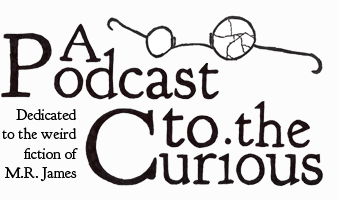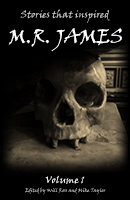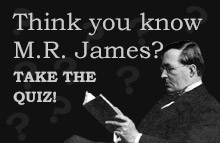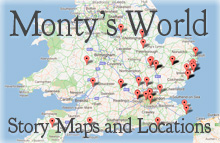 In this episode Mike & Will look into ghosts, golf and some decidedly fishy goings-on in Felixstowe in the first of a 2-part special on M.R. James’s ‘Oh, Whistle, and I’ll Come to You, My Lad’!
In this episode Mike & Will look into ghosts, golf and some decidedly fishy goings-on in Felixstowe in the first of a 2-part special on M.R. James’s ‘Oh, Whistle, and I’ll Come to You, My Lad’!
Big thanks to Tom Hemmings who returns as our reader for this episode.
Show Notes
- ‘Oh, Whistle and I’ll Come to You, My Lad’ by M.R. James
Read the full text at Wikisource.
- Felixstowe Golf Course and Beach on GoogleMaps
Here can be seen the real-world setting of ‘Oh, Whistle…’
- 1968 TV version on Youtube
Watch the BBCs classic adaptation, starring Michael Horden.
- 2010 TV version on IMDB
Read about the BBCs recent tv adaptation, starring John Hurt.
- Review of the 2010 TV version at The Gothic Imagination
Includes some very interesting discussion in the comments section.
- The Quadruple Object and Ontography
A website explaining the area of modern study now known at Ontography.
- Pilgrim’s Progress Quote
This is the section of John Bunyan’s Pilgrim’s Progress that comes to Parkins’ mind when seeing a figure following him along the beach.
- “I Shall Most Likely Be out on the Links”: Golf as Metaphor in the Ghost Stories of M. R. James. by Terry W. Thompson
A really interesting essay relevant to this story.
- The meaning of “Fur/Fla/Fle/Bus” at Ghosts & Scholars
Ghosts & Scholars provides a summary of the various speculations about the meaning of the text found on the whistle.
- Photo of the beach below Cobbolds Point, Felixstowe circa 1900
The more touristy part of the beach at Felixstowe, south of where Parkins had his horrible experience.
- Info on the Felixstowe Bath Hotel | Photo of Felixstowe Bath Hotel
This is the hotel on which James based The Globe Inn in ‘Oh, Whistle…’. The hotel is sadly no more, having been burned down by Suffragette arsonists on April 28th 1914!
- Image of ‘The Lodge’ Felixstowe | ‘The Lodge’ on GoogleMaps
This is the house owned by James’s friend Felix Cobbold, and where parties of friends from Kings College would meet for holidays (and probably a round of golf or two at the nearby golf course).
- Penelope Fitzgerald on M.R. James
In this 2000 article for the Guardian, author Penelope Fitzgerald examines James the man as well as James the writer and compares James’s personality to that of Parkins in ‘Oh, Whistle…’
- ‘Bleak and Solemn…’ at k-punk
This article retraces the Norfolk and Suffolk locations used in the filming of the 1960’s TV versions of ‘Oh, Whistle…’ and ‘A Warning to the Curious’. Photos are provided to show the locations as they are today (well, in 2007).
- Knights Templar on Wikipedia
Read about the history of this much-maligned order of religious knights.

Podcast: Play in new window | Download
Subscribe:
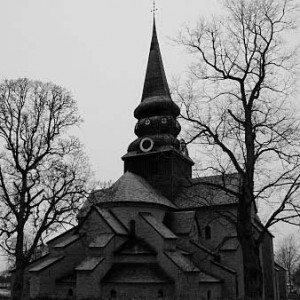 In this Christmas Special* Will and Mike get stuck into Count Magnus by M.R. James, and explore some startling questions:
In this Christmas Special* Will and Mike get stuck into Count Magnus by M.R. James, and explore some startling questions:
- What is the connection between Count Magnus and Ghostbusters 2?
- Will sewing your corpse into the carcass of a deer save your soul from the devil?
- Would Mr Wraxall prefer to have been shot in the balls by Robocop?
Answers to these questions and much, much more can be found in this bumber festive edition of the greatest and only M.R. James podcast! This episode features readings by Chris Savory.
Show notes:
* This edition may or may not feature Mike and Will singing an exclusive acapella rendition of ‘Oh Come All Ye Faithful’, accompanied by the choir of King’s College, Cambridge (spoiler alert: it doesn’t).
Podcast: Play in new window | Download
Subscribe:
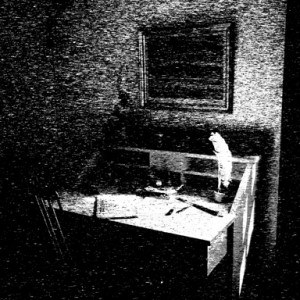 Mike is away on holiday at the moment so in lieu of a full episode we are pleased to present a full reading of M.R. James’s essay ‘Stories I Have Tried to Write’, read by Tom Hemmings!
Mike is away on holiday at the moment so in lieu of a full episode we are pleased to present a full reading of M.R. James’s essay ‘Stories I Have Tried to Write’, read by Tom Hemmings!
Regular service will resume in a few weeks when Mike returns from his reckless galavanting.
Notes
‘Stories I have Tried to Write’ was written by M.R. James in November of 1929 and first published at the end of that month in ‘The Touchstone 2’, a publication of Eton College where James was Provost at the time. The editors would no doubt have preferred to have received a completed ghost story of the sort James had produced for the Eton Boy Scouts two years previously (‘Wailing Well’, one of the last James ghost stories to find print during his lifetime) but instead they received a short essay in which James runs briefly through a number of story ideas that never saw completion.
Some of these stories are the merest hint of an idea (the Christmas cracker, the tap on the shoulder) while others provide the outline of an almost completed story, with settings, characters, names and so on all prepared. As James mentions in the essay, some of these stories he not only tried to write, but did write, only later deciding they were not good enough for publication. A draft of the Marcilly-le-Hayer story can be found among James’s papers in King’s College Library and was publishes in Ghosts & Scholars 22 in 1996. Likewise, the draft of the story involving two students at King’s was found and published in Ghosts & Scholars 12 as ‘The Fenstanton Witch’.
Other story elements James mentions in the essay hint at plot devices that James did actually use in some of his published stories, for instance the mask that appears amongst the curtains brings to mind the leering face that peers through the hedge in ‘The Rose Garden’ and similarly in James’s story ‘A Vignette’, a story written in 1935 and not published until after his death in 1936. James’s reference to ‘common objects being vehicles of malice’ was an idea he later fleshed out into the macabrely humorous fable ‘The Malice of Inanimate Objects’ which was printed in another Eton publication, ‘The Masquerade 1’ in 1933.
The essay saw wider publication when it was included in The Collected Ghost Stories of M.R. James (Arnold 1931), and since that time many authors have yielded to the temptation to flesh James’s ideas out into complete stories. The most notable being Sheila Hodgson who produced not only a series of stories based on the ideas (published by Ash Tree Press in 1998 as ‘The Fellow Travellers and Other Ghost Stories’), but a highly enjoyable series of radio plays which were broadcast on BBC Radio 4 between 1976 and 1992. As far as I am aware these radio plays have never seen the light of day on cassette or cd but can be tracked down by anyone with a search engine, bit torrent client and ‘relaxed’ attitude towards copyright law. Or so I am told. *cough*.
More information on the essay and the various stories it has inspired can be found in the excellent ‘Stories I Have Tried to Write’ story notes at Ghosts & Scholars.

Podcast: Play in new window | Download
Subscribe:
 In this episode Mike & Will look into ghosts, golf and some decidedly fishy goings-on in Felixstowe in the first of a 2-part special on M.R. James’s ‘Oh, Whistle, and I’ll Come to You, My Lad’!
In this episode Mike & Will look into ghosts, golf and some decidedly fishy goings-on in Felixstowe in the first of a 2-part special on M.R. James’s ‘Oh, Whistle, and I’ll Come to You, My Lad’!